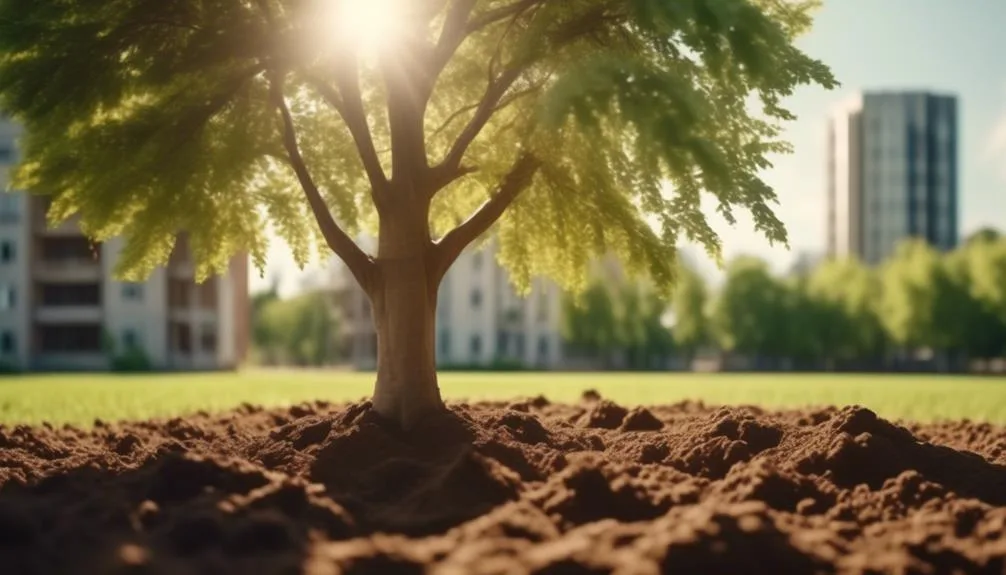Looking to plant hickory trees but not sure where to start?
It's important to know the best placement for their growth. Factors like sunlight and soil type play a crucial role.
We'll guide you through the basics of where to plant hickory trees, helping you make informed decisions for their long-term well-being.
Sunlight Requirements
To ensure the best growth of hickory trees, you should plant them in a location that receives full sunlight for at least six to eight hours a day. Hickory trees, belonging to the Carya genus, thrive in full sunlight, making it essential for their growth rate. These majestic tree species are known for their slow to moderate growth, and adequate sunlight is crucial for their development.
When hickory trees receive sufficient sunlight, they can photosynthesize effectively, producing the energy needed for growth and development. Without proper sunlight, the growth rate of hickory trees may be stunted, impacting their overall health and longevity.
Therefore, when selecting a location for planting hickory trees, ensure it provides the necessary sunlight to support the optimal growth of this remarkable tree species.
Soil Conditions
You can ensure the successful growth of hickory trees by planting them in well-draining, loamy soil that's slightly acidic and rich in organic matter. The pH levels of the soil should ideally range from 5.5 to 6.5 to support optimal nutrient absorption. Proper drainage is crucial as hickory trees are susceptible to root rot in waterlogged conditions.
Additionally, the nutrient composition of the soil is essential for the hickory trees to thrive. The soil should be rich in essential nutrients such as nitrogen, phosphorus, and potassium. Compacted soil can hinder root development, so it's important to ensure that the soil is loose enough to allow for proper root growth.
Watering Needs
When caring for hickory trees, it's important to provide consistent and deep watering to promote strong root development and overall tree health. Watering frequency is crucial, especially during the tree's early years. For the first few years, water the hickory tree deeply once a week, ensuring the water reaches a depth of at least 12 inches to encourage deep root growth.
As the tree matures, monitor the soil moisture regularly and adjust the watering frequency based on the specific needs of the tree and the prevailing weather conditions. Hickory trees exhibit good drought tolerance once established, but adequate watering is still essential during dry periods to maintain tree vigor.
Applying a layer of mulch around the base of the tree can help conserve soil moisture and reduce water loss through evaporation, promoting healthy root growth.
Spacing and Location
Consider the ideal spacing and location for planting hickory trees to ensure optimal growth and development. When determining where to plant hickory trees, it's crucial to consider their growth rate and root depth. Hickory trees have a moderate to fast growth rate, so they require sufficient space to expand and develop. Additionally, their deep root system necessitates careful consideration of location to avoid potential interference with underground utilities or nearby structures.
| Factors | Ideal Conditions | Considerations |
|---|---|---|
| Growth Rate | Moderate to fast | Provide ample space for growth |
| Root Depth | Deep | Avoid planting near underground utilities or structures |
Potential Obstacles
Watch out for potential obstacles when planting hickory trees to ensure successful growth and development.
One common challenge is the susceptibility of hickory trees to various tree diseases and pests. Keep an eye out for signs of diseases such as leaf spot, anthracnose, and cankers, and promptly address any issues to protect the health of your hickory trees.
Additionally, pests like hickory shuckworms and pecan weevils can impact nut production, so it's essential to monitor for their presence and take appropriate measures to control their population.
Proper maintenance practices, such as regular pruning and ensuring good air circulation, can help prevent disease and pest issues.
Conclusion
In choosing the right location with sunlight, well-draining soil, and adequate spacing, you set the stage for your hickory tree to flourish.
By considering its watering needs and potential obstacles, you pave the way for a thriving addition to your landscape.
How will your thoughtful selection and care for this tree enhance your outdoor space?
Mark Hoffman is a dedicated arborist and tree care specialist with over a decade of experience. His love for trees began when he visited Yosemite National Park as a teenager and was awestruck by the giant sequoias. Mark pursued his passion by studying forestry at Michigan Technological University, where he earned a Bachelor of Science degree.
Since then, he has worked tirelessly in the field of arboriculture, helping to preserve and protect trees in his community. His expertise and dedication have made him a respected leader in the industry and a valuable resource for anyone seeking advice on tree care.
